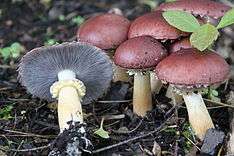Stropharia rugosoannulata
| Stropharia rugosoannulata | |
|---|---|
 | |
| Scientific classification | |
| Kingdom: | Fungi |
| Division: | Basidiomycota |
| Class: | Agaricomycetes |
| Order: | Agaricales |
| Family: | Strophariaceae |
| Genus: | Stropharia |
| Species: | S. rugosoannulata |
| Binomial name | |
| Stropharia rugosoannulata Farlow ex Murrill (1922) | |
| Synonyms[1] | |
|
Geophila rugosoannulata (Farl. ex Murrill) Kühner & Romagn. (1953) | |
| Stropharia rugosoannulata | |
|---|---|
|
| |
| gills on hymenium | |
|
cap is convex or flat | |
| hymenium is adnate | |
| stipe has a ring | |
| spore print is purple | |
| ecology is saprotrophic | |
| edibility: choice | |
Stropharia rugosoannulata, commonly known as the wine cap stropharia, "garden giant", burgundy mushroom or king stropharia (Japanese: saketsubatake), is an agaric of the family Strophariaceae found in Europe and North America, and introduced to Australia and New Zealand.
Unlike many other members of the genus Stropharia, it is widely regarded as a choice edible and cultivated for food.
The king stropharia can grow to 20 cm high with a reddish-brown convex to flattening cap up to 30 cm across, the size leading to another colloquial name godzilla mushroom.[2] The gills are initially pale, then grey, and finally dark purple-brown in colour. The firm flesh is white, as is the tall stem which bears a wrinkled ring. This is the origin of the specific epithet which means "wrinkled-ringed".[3]
It is found on wood chips and bark mulch across North America in summer and autumn. Described as very tasty by some authors, king stropharia is easily cultivated on a medium similar to that on which it grows naturally. Antonio Carluccio recommends sautéeing them in butter or grilling them.[2]
In Paul Stamets' book Mycelium Running, a study done by Christiane Pischl showed that the king stropharia makes an excellent garden companion to corn. The fungus also has a European history of being grown with corn.
A 2006 study, published in the journal Applied and Environmental Microbiology, found the king stropharia to have the ability to attack the nematode Panagrellus redivivus; the fungus produces unique spiny cells called acanthocytes which are able to immobilise and digest the nematodes.[4] See nematophagous fungus.
References
- ↑ "Stropharia rugosoannulata Farl. ex Murrill 1922". MycoBank. International Mycological Association. Retrieved 2011-09-11.
- 1 2 Carluccio A (2003). The Complete Mushroom Book. Quadrille. ISBN 1-84400-040-0.
- ↑ Pacioni G (1981). Simon & Schusters Guide to Mushrooms. Simon & Schuster. ISBN 0-671-42849-7.
- ↑ Hong Luo; Xuan Li; Guohong Li; Yanbo Pan & Keqin Zhang (2006). "Acanthocytes of Stropharia rugosoannulata Function as a Nematode-Attacking Device". Appl. Environ. Microbiol. 72 (4): 2982–7. doi:10.1128/AEM.72.4.2982-2987.2006. PMC 1449000
 . PMID 16598005.
. PMID 16598005.
Cited literature
- Phillips, Roger (1991). Mushrooms of North America. Little, Brown & Co. ISBN 0-316-70613-2.
- Zadrazil, Frantisek and Joachim Schliemann: "Ein Beitrag zur Ökologie und Anbautechnik von Stropharia rugosoannulata (Farlow ex Murr.)" in: Der Champignon Nr.163, March 1975